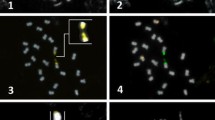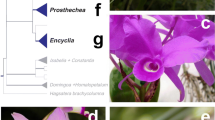Abstract
Species belonging to the Alismataceae (Echinodorus) and Limnocharitaceae (Hydrocleys and Limnocharis) families were analysed by banding with CMA/DAPI fluorochromes, C/CMA/DAPI banding, and in situ hybridization (FISH) with probes that recognise 45S rDNA. All species of Echinodorus presented 2n = 22, but only in E. lanceolatus were DAPI+ telomeric bands in seven chromosome pairs observed. A bimodal karyotype and GC-rich heterochromatin preferably located in two smaller acrocentric pairs that generally corresponded to the number of sites of 45S rDNA. A similar pattern of bands was observed in both Limnocharis species (2n = 20), but the two differed with respect to 45S rDNA, with L. laforestii showing only two sites. Hydrocleys nymphoides and H. martii had a chromosome number of 2n = 16, but the position of the GC-rich heterochromatin associated with the satellite differed among chromosomal types. In this work, the cytotaxonomic implications of these patterns are discussed and correlated with previous data from the literature.




Similar content being viewed by others
References
Angiosperm Phylogeny Group (1998) An ordinal classification for the families of flowering plants. Ann Missouri Bot Gard 85:531–553
Angiosperm Phylogeny Group II (2003) An update of the Angiosperm Phylogeny Group classification for the orders and families of flowering plants: APG II. Bot J Linn Soc 141:399–436
Buznego M, Perez-Saad H (2006) Behavioral and antiepileptic effect of acute administration of the extract of the aquatic plant Echinodorus berteroi Sprengel. Epilepsy Behav 9:40–45
Carvalho R, Soares Filho WS, Brasileiro-Vidal AC, Guerra M (2005) The relationship among lemons, limes and citron: a chromosomal comparison. Cytogenet Genome Res 109:276–282
Chase MW, Soltis De Soltis PS, Rudall PJ, Fay MF, Hahn WH, Sullivan S, Joseph J, Molvray M, Kores PJ, Givnish TJ, Sytsma KJ, Pires JC (2000) Higher-level systematic of the monocotyledons: an assessment of current knowledge and a new classification. In: Wilson KL, Morrison DA (eds) Monocots: systematics and evolution. CSIRO, Melbourne, pp 3–16
Chen JM, Chen D, Robert W, Wang GF, Guo YH (2004) Evolution of apocarpy in Alismatidae using phylogenetic evidence from chloroplast rbcL gene sequence data. Bot Bull Acad Sim 45:33–40
Costa YJ, Forni-Martins ER (2003) Karyology of some Brazilian species of Alismataceae. Bot J Linn Soc 143:159–164
Costa YJ, Forni-Martins ER (2004) A triploid cytotype of Echinodorus Tennellus. Aquat Bot 79:325–332
Costa YJ, Forni-Martins ER, Vanzela ALL (2006) Karyotype characterization of five Brazilian species of Echinodorus (Alismatales) with chromosomal banding and 45s DNAr FISH. Pl Syst Evol 257:119–127
Costa YJ, Vanzela ALL, Forni-Martins ER (2007) Variação cromossômica interpopulacional no número de sítios 45S de DNAr de Sagitária rhombifolia (Alismataceae). II Simpósio Latinoamericano de Citogenética y Evolución, Colômbia
Dahlgren RMT, Clifford HT, Yeo PF (1981) The families of the monocotyledons. Springer, Berlin
Feitoza LL, Felix LP, Castro AAJF, Carvalho R (2009) Cytogenetics of Alismatales s.s.: chromosomal evolution and C-banding. Plant Syst Evol 280:119–131
Forni-Martins ER, Calligaris KP (2002) Chromosomal studies on Neotropical Limnocharitaceae (Alismatales). Aquat Bot 74:33–41
Galasso L, Schmidt T, Pignone D, Heslop-Harrison JS (1995) The molecular cytogenetics of Vigna unguiculata (L.) Walp: the physical organization and characterization of 18s-5.8s-25s rRNA genes, 5s rRNA genes, telomere-like sequences, and a family of centromeric repetitive DNA sequences. Theor Appl Genet 91:928–935
Guerra M (2000) Patterns of heterochromatin distribution in plant chromosomes. Genet Mol Biol 23:1029–1041
Harada I (1956) Cytological studies in Helobiae. Part I. Numbers in seven families. Cytologia 21:306–328
Haynes RR, Holm-Nielsen LB (1986) Notes on Echinodorus (Alismataceae). Brittonia 38:325–332
Haynes RR, Holm-Nielsen LB (1992) The Limnocharitaceae. Flora Neotropica. Monograph 62. The New York Botanical Garden, New York
Haynes RR, Holm-Nielsen LB (1994) The Alismataceae. Flora Neotropica, monograph 64. The New York Botanical Garden, New York
Judd WS, Campbell CS, Kellogg EA, Stevens PF (1999) Plant systematics: a phylogenetic approach. Sinauer Associates, Sunderland
Kenton A (1981) A Robertsonian relationship in the chromosomes of two species of Hydrocleys. Kew Bull 36:487–492
Lehtonen S (2006) Phylogenetics of Echinodorus (Alismataceae) based on morphological data. Bot J Linn Soc 150:291–305
Morawetz W (1986) Remarks on karyological differentiation patterns in tropical woody plants. Pl Syst Evol 152:49–100
Moscone EA, Matzke MA, Matzke AJM (1996) The use of combined FISH/GISH in conjunction with DAPI counterstaining to identify chromosomes containing transgene inserts in amphidiploid tobacco. Chromosoma 105:231–236
Sato S, Yoshioka T (1984) Heterogeneity of heterochromatin segments in Nothoscordum fragrans chromosomes. Caryologia 37:197–205
Schwarzacher T, Ambros P, Schweizer D (1980) Application of Giemsa banding to orchid karyotype analysis. Plant Syst Evol 134:293–297
Schweizer D (1976) Reverse fluorescent chromosome-banding with chromomycin A and DAPI. Chromosoma 58(4):307–324
Souza VC, Lorenzi H (2005) Botânica Sistemática: Guia ilustrado para identificação das famílias de Angiospermas da Flora Brasileira, baseado em APG II. Instituto Plantarum de Estudos da Flora, São Paulo
Yamamoto M, Tominaga S (2003) High chromosomal variability of mandarins (Citrus spp.) revealed by CMA banding. Euphytica 129:267–274
Acknowledgments
We thank the CNPq for the fellowship award to the first author, Prof. Marcelo Guerra of the Botany Department of Federal University of Pernambuco for allowing the use of the photomicroscope and TROPEN Institute (Núcleo de Referência em Ciências Ambientais do Trópico Ecotonal do Nordeste) for providing plant material and financial support.
Author information
Authors and Affiliations
Corresponding author
Rights and permissions
About this article
Cite this article
Feitoza, L.L., Martins, M.I.G., Castro, A.A.J.F. et al. Cytogenetics of Alismataceae and Limnocharitaceae: CMA/DAPI banding and 45S rDNA sites. Plant Syst Evol 286, 199–208 (2010). https://doi.org/10.1007/s00606-010-0300-7
Received:
Accepted:
Published:
Issue Date:
DOI: https://doi.org/10.1007/s00606-010-0300-7




